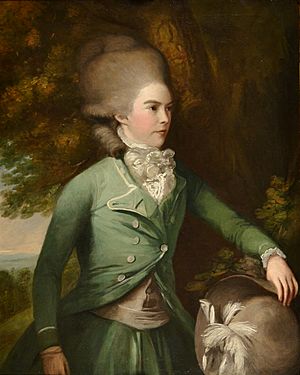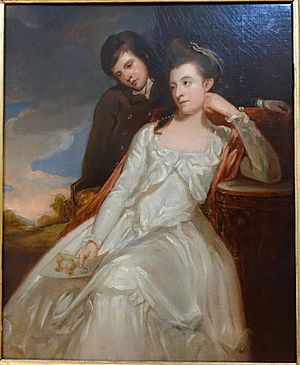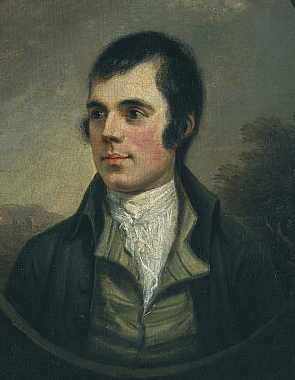Jane Gordon, Duchess of Gordon facts for kids
Quick facts for kids
The Duchess of Gordon
|
|
|---|---|

Jane, Duchess of Gordon, by Daniel Gardner, c. 1780
|
|
| Born |
Jane Maxwell
1748 or 1749 Myrton Castle, Monreith, Wigtown, Scotland
|
| Died | 14 April 1812 Pulteney's Hotel, Piccadilly, London, England
|
| Spouse(s) | |
| Children |
|
| Parent(s) |
|
Jane Gordon, Duchess of Gordon (born Jane Maxwell; 1748 or 1749 – 14 April 1812) was a famous Scottish socialite and political hostess. She was known for her lively parties and her strong support for Scottish culture. With her husband, Alexander, 4th Duke of Gordon, and her son George, she helped create the Gordon Highlanders. This was a famous British Army infantry regiment that existed until 1994.
Contents
Early Life and Family History
Jane Maxwell was the fourth child of Sir William Maxwell, the 3rd Baronet of Monreith. Her mother was Magdalene Blair. Jane was born at Myrton Castle, which is now a ruin. It was near Monreith House, the family's home built later.
The Maxwell family of Monreith was connected to the powerful Maxwells of Caerlaverock Castle. These were the Earls of Nithsdale, one of Scotland's most important families in the 1600s. Jane's grandmother was also the daughter of the 9th Earl of Eglinton. He was a leader of a large landowning family in Ayrshire.
In 1760, Jane's father, Sir William, sold much of his large estate. He did this to pay off debts. Jane, her mother, and her two sisters then lived in Edinburgh. They stayed at Sir William's house, Shrub Hill, on Leith Walk. They might have also rented a flat near Royal Mile for city events.
Many Scottish landowning families rented homes in Edinburgh. This allowed their daughters to get more education and join Edinburgh society. Jane's mother moved there in 1760 with her three daughters. These were Catherine (13), Jane (11), and Eglantine (9). Sir William stayed at Monreith with his sons.
The family lived simply in Edinburgh. The children often played in the streets. When Jane was 14, she had an accident. Her finger got caught in a cart wheel and was torn off. She later wrote a letter about it with her left hand. After this, she always wore gloves to hide the missing finger. She sometimes used a wooden finger inside her glove. One of these wooden fingers is still at Monreith House. She often said it was a coaching accident.
When Jane turned 16, people said she was very beautiful. A song was even written about her called "Bonnie Jennie of Monreith, the Flower of Galloway." Around this time, she fell in love with a young officer. He was likely a Fraser, related to Lord Lovat. He left with his regiment, possibly for America. Later, she heard that he had died.
Marriage and Family Life
On October 18, 1767, Jane married Alexander Gordon, 4th Duke of Gordon. He was 24 years old. The young Duke lived in a townhouse almost across from the Maxwells. He had inherited a large fortune and his title when he was only nine.
During their honeymoon, Jane received a surprising note. It was from her first love, the young Fraser. He was alive and asked her to marry him. She reportedly fainted after reading the note. However, she did stay in touch with him.
For the next 20 years, the Duke and Duchess lived at Gordon Castle in Morayshire. Jane's husband made the castle one of the largest homes in Scotland. Its front was 600 feet long, and it had an 84-foot-high central tower. Part of the town of Fochabers had to be moved to make space for the castle's expansion. However, many years later, most of these additions were taken down.

At Gordon Castle, Jane hosted many parties. She also enjoyed planting trees and was very interested in farming. She loved local dancing, fiddle, and pipe music. She is often given credit for making the Strathspey a popular dance.
Jane and the Duke had seven children. Their first son, George, Marquess of Huntly, was born in 1770. He later became the 5th Duke of Gordon.
Supporting Robert Burns
Jane became known for her very grand parties. Sometimes, as many as 100 guests would sit down for dinner. Guests often stayed at the castle for three months. In the 1780s, the Duchess started hosting parties in Edinburgh. She quickly became the most important hostess there. Jane was seen as the leader of fashion in Edinburgh. Horace Walpole even called her the "Empress of fashion."
She regularly held evening gatherings where new artists were invited to perform. It was in her drawing room that the famous poet Robert Burns first read his poems to Edinburgh society. Jane became his main supporter. She bought all his early published works.
Moving to London and Influence

In 1787, the Duke and Duchess of Gordon moved to London. They first rented houses on Downing Street and then in Pall Mall. Finally, they settled in St. James's Square. Jane continued her tradition of throwing parties, but with a special Scottish touch. She made everyone dance Scottish dances.
King George III liked her very much. Because she supported the King, she was allowed to promote her Scottish heritage more openly than others. She even held a ball where she and the Duchess of York wore tartan. This was at a time when tartan was officially banned. She also arranged for the King to inspect troops wearing tartan in Hyde Park.
Her biggest parties were held in her Pall Mall house. Since it was close to Parliament, she kept an open house for the Tories. Important politicians like Pitt, the Prime Minister, and Dundas often visited. During this time, she helped create a truce between the King and his oldest son, the Prince of Wales. The Prince had huge debts. Jane helped arrange for his debts to be paid. This allowed the building of the Royal Pavilion at Brighton to continue.
Founding the Gordon Highlanders
In 1793, the French Revolutionary Government declared war on Great Britain. At that time, the British army needed more soldiers. Military service was not very popular. So, the Government asked Jane’s husband, the Duke of Gordon, to create a new regiment.
This led to a famous bet between Jane and the Prince of Wales, who would later become King George IV. Jane bet the Prince that she could recruit more men than the Government. Even though she was 45, she was still very charming. She used this to help her recruiting efforts. She wore a military uniform and a large black feathered hat (a highland bonnet). She traveled around Scotland, organizing traditional Scottish dances called reels. Anyone who joined the dance also joined the army. They received the King’s shilling, which was a payment for joining, by kissing the Duchess. This is how the Gordon Highlanders were founded. She recruited 940 men. On June 24, 1794, the new regiment paraded for the first time in Aberdeen. The regiment continued to exist until 1994.
Life at Kinrara House
In 1799, Jane became sad and unwell. Her oldest son, George, had gone off to war. She wrote in a letter, "Oh where and oh where has my highland laddie gone?" Her second son, Alexander (1785–1808), died at age 23. Her husband had moved his companion, Jane Christie, into Gordon Castle. He built a small house for his estranged wife on the Spey, called Kinrara. Jane lived there for the next six years, still hosting parties and entertaining guests.
Daughters' Marriages
Jane had enjoyed her life as a Duchess. She was determined to ensure her daughters married well. She worked hard to find suitable husbands for them.
Jane first focused on finding a husband for Charlotte (1768–1842), her oldest daughter. She tried to arrange for her to marry William Pitt, the Prime Minister. But her plan did not work out. Charlotte later married Colonel Charles Lennox, who became the 4th Duke of Richmond, on September 9, 1789. The wedding was at Gordon Castle.
In 1802, after the Peace of Amiens, Jane took her youngest daughter, Georgiana (1781–1853), to Paris. She hoped Georgiana might marry the son of Empress Joséphine, Eugène de Beauharnais. This idea was not popular so soon after the war, and nothing came of it. A short time later, Georgiana was thought to be close to Francis Russell, 5th Duke of Bedford. But he died before they could marry. Jane then arranged a meeting with the Duke’s younger brother, John Russell, 6th Duke of Bedford. He had inherited the title and was recently widowed with several children. Everything went as planned. He married Georgiana on June 23, 1803, in London. Georgiana had ten children with the Duke. She followed her mother's example, hosting many parties at her home, Woburn Abbey.
General Cornwallis returned to England after leading British troops during the American Revolution. He was surprisingly treated as a hero and given the title of Marquess. He had fought with Jane’s brother in India and America. So, he was friendly with Jane. His oldest son, Lord Brome, was considered a good match for Louisa (1776–1850), Jane's fourth daughter. Cornwallis initially refused to approve the marriage. He was worried about mental health issues in the Gordon family. The Duchess calmed his fears by saying that Louisa did not have "one drop of Gordon blood." The marriage then happened on April 17, 1795, in London.
Susan (1774–1828), the third daughter, married William Montagu, 5th Duke of Manchester on October 7, 1793, in Edinburgh. Madeleine (1772–1847), the second daughter, first married Sir Robert Sinclair, 7th Baronet, on April 2, 1789, in London. On November 25, 1805, she married Charles Fysche Palmer at Kimbolton Castle.
Later Life and Legacy
Jane’s own marriage had become difficult over time. By 1805, the marriage was officially over. Jane and the Duke reached a financial agreement. The Duchess was to receive a new house, money payments, and generous annual payments. However, the Duke was having money problems. He admitted he owed her money but did not pay all that was due.
Jane ended up living in hotels. She became more unusual in her behavior. She was in a bitter dispute with her estranged husband over money. She died in 1812 at Poultney’s Hotel in Piccadilly, London. Her four daughters and surviving son were with her. Her body was taken north to be buried at the old Celtic Chapel by the River Spey at Kinrara. There, her husband fulfilled her last wish and built a monument for her. It listed the marriages of her children.

Jane, Duchess of Gordon, was painted by many leading English portrait artists. These included George Romney, Sir Joshua Reynolds, Sir Henry Raeburn, and Daniel Gardner. But she was known for more than just her looks. People remembered her intelligence, her infectious laugh, and her sense of humor. She seemed to have a lot of energy, which she used to support causes she believed in. She made a lasting impact by helping Scotland and Scottish culture become accepted by the new Kings of Great Britain, who had German roots.
She is also remembered in the poems of Robert Burns, whom she supported early in his career:
She kiltit up her kirtle weel
To show her bonie cutes sae sma’,
And walloped about the reel,
The lightest louper o’ them a’!
While some, like slav’ring, doited stots
Stoit’ring out thro’ the midden dub,
Fankit their heels amang their coats
And gart the floor their backsides rub;
Gordon, the great, the gay, the gallant,
Skip’t like a maukin owre a dyke:
Deil tak me, since I was a callant,
Gif e-er my een beheld the like!
See also
- Jane, Duchess of Gordon (1805 EIC ship)


